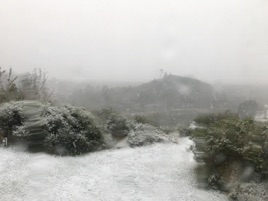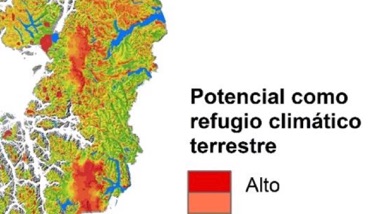

Climate issues
The Private protected area Pichimahuida (PPAP) is located in the Leones valley, east of the Andes between the lake General Carrera and the Northern ice field.
The valley has continental trans-andean temperate cold boreal climate, with cold boreal forest and progressive change into shrub steppes, as result of deforestation and overgrazing. Leones valley is one of the coldest of the region. The Northern Ice Field is exercising a cooling effect. The moderating effect of the lake General Carrera: the valley has less extreme weather than places further away from the lake. The valley has its own microclimate, maybe less vulnerable to climate change. It might serve as a “temporal corridor” for ecosystem conservation.
There is no point in looking for signals from previous climate changes in the valley, as any of these have been swamped by the destructive fires and other anthropogenic impacts in the last 80 years.
Due to massive deforestation the usual climate-modulating effect of forests is almost absent, the trees do not absorb as much CO2 as expected. The regional climate is more resilient to climate change thanks to the Andes mountain chain.
The PPAP is:
An option for a natural climate buffer;
Providing for an option of a “temporal corridor” for land conservation and nature restoration in a changing climate;
Restoring peat lands, which are storing more carbon (CO2) than all other vegetation types including the growing forests.
However, benefits of restoration decline rapidly with climate warming:
- Climate change, quite visible in the valley and the region, has to be taken into account in order to anticipate pressure on the reforestation project. The project is studying ancient climates, as by 2030 the global climate of the Earth will look like that of three millions years ago: Le climat de la Terre va ressembler à celui d'il y a trois millions d'années.pdf , as well as the impact of ecocides on climate.
-
-Extreme weather episodes, resulting from climate change, change the ecosystems: annual species can adapt, not the perennial ones. With climate change pine forests are replaced by leafy tree species.
-
-The Leones glacier is due to disappear soon, Almost 40% of world’s glaciers already doomed due to climate crisis.
-
-In the era of climate change reference ecosystems in restoration become irrelevant.
-
-The major problem of climate change in protected areas is destruction of the forest and of the quality of the forest.
Rewild to mitigate the climate crisis
In the area the weather is dominated by two factors. The first, and there is no equivalent part in the world in which this factor plays such a crucial role, is the very strong and highly predominant west wind while the second one are the Andes and their ice fields, in particular the fast melting Patagonian northern ice field. The area has strong west winds year-round, these winds put the vegetation under stress due to enhanced evapotranspiration. In the region the cold is a strong limiting factor, reducing the warm season to 4-5 and sometimes just to 2-3 months only. There are only small seasonal changes in the temperature regime in contrast to the same latitude in the northern hemisphere, but "all the seasons can be observed in a single day”.
The PPAP registered:
The strongest wind was 71 m/s or 200 km/h- just a gust.
It is not unusual to have sustained winds of 20 -25 m/s or 80 km/h.
There were extreme rain events in August 2010 and again in May 2011, resulting in with floods and landslides. As well as in March 2023.
Thunderstorms, unknown until recently in the region, are due to climate change.
Several years of drought, drought and humidity are expected to increase. With climate change, arid regions are becoming increasingly dry, while humid regions have become more humid.
Weather records for the last 19 years are available in the project.

Major landslide in the valley 2011
Weather forecast sites usually underestimate the influence of the Northern Patagonian ice field on the Leones valley and forecast more precipitations and less wind than in reality.
Contribution of the region to the climate change:
-
• Clearing fires of last century lead to a region-wide increase of carbon emissions. Fires accelerate global warming because of
the enormous quantities of carbon dioxide released in the atmosphere.
-
• Massive deforestation by fire lead to drastic reduction in greenhouse gases absorption.
-
• Change of land use for agriculture is a major contributor to climate change,
Changes in land use and climate change.pdf
-
• Massive draining of wetlands in the region contributed to local climate change,
Large influence of soil moisture on long-term terrestrial carbon uptake.pdf
-
• Livestock: 55% of the greenhouse gas emitted by agriculture come from livestock.
-
• Massive wetland’s sphagnum mining in the region (legal and illegal) has undermined its carbon storage potential.
-
• Soil and moisture have a great influence on climate: the soil of the Leones valley, and of its region, is seriously degraded.
The present regional policies continue to contribute actively to global climate change
and to the acceleration of the climate change in the region, rather than adapting to it.
!!! The main factor is the promotion of mass tourism in the region, in particular international tourism. Impact of mass tourism on climate change is enormous. Cruise ships emit three times more CO2 than airplanes
!!! The second important factor is the serious deficiency in enforcement of the legislation
relevant to nature protection in the region.
!!! The third important issue is the absence of support from the local authorities to native reforestation, which is a
cost-effective, scalable, and proven solution to climate change, one of the main means of climate mitigation.
Majority of offset projects that have sold the most carbon credits are junk.
The local ecosystem, novel and fragile, is exposed and very sensitive to climate change,
for it the climate changed already 80 years ago.
Additional regional issues:
-
• The still active sphagnum (peat) exploitation in the region leads to acceleration of climate change
as peat bogs act as carbon sinks.
-
• The hole in the ozone layer over the region affects the climate of the region more than do the greenhouse gases,
this phenomenon might persist until 2050-2060.
-
• Water crisis in the region will intensify with climate breakdown.
-
• The Southern Ocean is expelling massive quantities of CO2, Massive ocean carbon sink spotted burping CO2 on the sly.pdf,
World’s oceans are losing power to stall climate change (United Nations);
-
• El Niño effects are generally quite prominent in the region, El Niño events will intensify under global warming.pdf
Some relevant resources:
WMO 2025: There is a forecast 70% chance that the five-year average warming for 2025-2029 will be more than 1.5°C, according to the report. This is up from 47% in last year’s report (for the 2024-2028 period) and up from 32% in the 2023 report for the 2023-2027 period.
According to the IPCC report, the world is descending into a climate ‘doom loop’ :
- Global temperatures set to reach new records in next five years;
- Human-induced global warming of 1.1 degrees C has spurred changes to the Earth’s climate that are unprecedented in recent human history.
- Climate impacts on people and ecosystems are more widespread and severe than expected, and future risks will escalate rapidly with every fraction of a degree of warming.
- Some climate impacts are already so severe they cannot be adapted to, leading to losses and damages.
All top 10 findings. Global fire emissions database.
Copernicus online portal offers terrifying view of climate emergency.
Holocene environmental and climate evolution of central west Patagonia as reconstructed from lacustrine sediments of Meseta Chile Chico (46.5° S, Chile).
Adaptation to climate change? Really?
-
• It’s probably too late, as the climate disaster is here and the total climate meltdown cannot be stopped.
And climate adaptation is virtually impossible.
-
• Adapting to climate breakdown is very expensive, the region might not have the resources.
-
• Climate projections: Change might happen very abruptly, the glaciers might melt and disappear very fast.
-
• Economic damage from climate change six times worse than thought.
-
• Global farming: 21% of productivity is lost because of climate change.
-
• Hydric stress: https://egusphere.copernicus.org/preprints/2024/egusphere-2024-2695/
Climate moderation solutions quite often are damaging for nature:
Climate moderation policies are a major deforestation factor in Europe: can cutting down ancient trees be good for the Earth?
Climate moderation policies can undermine nature restoration perspectives;
Energy wood pellets; Forest cuts for solar energy farms.
Bird population declines due to renewable power sources. Trees cut down massively to make way for wind farms.
Summer in Leones valley

Wildlife:
-
• Declines in animal and bird species have vastly limited the ability of plants to adapt to climate change.
-
• With global warming, the gap between the now earlier availability of food and the birth of chicks, which occurs at the same time, will increase. This is one of the mechanisms that explains why climate change is the cause of many extinctions.
-
• Due to global warming species are shrinking. 'Ghastly future of mass extinction' and climate disruption.
-
• Climate change has a significant impact on the emergence of animal diseases.
-
• Cloud formation has been disrupted, as living organisms affect clouds and are very important for cloud formation.
Earth is having fever and we are the virus - adapted from James Lovelock.
“The impact of melting glaciers will have a catastrophic effect in Chile, unlike in other regions of the world”,
Prof. Martin Beniston, University of Geneva
World is at its hottest for at least 12,000 years CO2 in Earth's atmosphere nearing levels of 15m years ago
